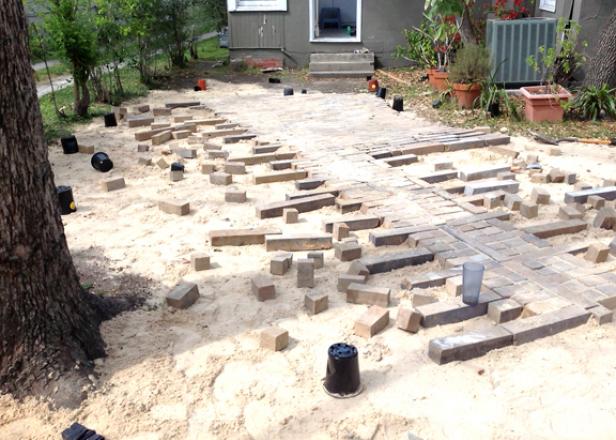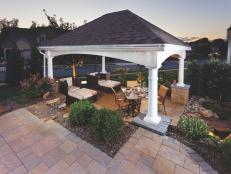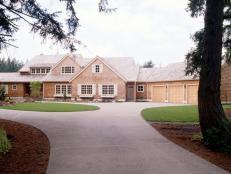Hardscaping Basics

Hardscaping is a blanket term used for “the built environment” in the landscape, as opposed to softscaping which includes soil and plants. Walkways, patios, retaining walls and fountains are a few examples. Though hardscaping projects provide ample opportunities to flex creative muscle in your landscape, there are a few basic concepts to implement in the planning and construction of hardscapes that will lead to successfully building features that will stand the test of time and the elements.
Leveling
If you think your sloped backyard is a tough place to work, imagine what it took for the Incas to build Machu Picchu. The first force to oppose your hardscaping project is gravity. You are fighting gravity when you work on a slope or when you build up from the ground. The way you fight gravity is with a level foundation. Not all projects will be leveled in the same way. A wall works best when each block or timber in its base layer is level—the leveled blocks can be stair-stepped to accommodate a slope along the run of the wall. A flagstone pathway should be leveled across the width of the path, even though it may run up and down slight grades along its linear axis. Water features must be level in all directions, or else they won’t hold water for long!
Some handy tools to help in the leveling stage include:
- 48 inch mason’s level, useful for landscape timbers and pathway projects.
- 6 inch torpedo level, works well for block retaining wall projects.
- Post level, finds level in two directions - ideal for corner posts.
- Line level, attaches to a mason’s line for finding level over longer distances.
Working With Water
To look at the terraced rice paddies in China, it is a wonder that they exist. Not to mention that they have existed for a very, very long time. This is a wonderful example of understanding the value of carefully leveling a project, as well as reminding us that we must consider the force of water. Whether or not the water will be used within the scope of the hardscape project, attention must be paid to this important aspect or else you risk damage and destruction from runoff.
Consider: Unless the project is exactly at the top of hill, rainwater from higher elevations will come into play. Where will runoff enter and exit the project? Should it be accommodated with drain pipe or some other diversion? Where will these elements be installed? If you are creating a large impervious area like a concrete patio or driveway, it will be a brand new source of runoff that will require elements to channel, dissipate, slow or hold the rainwater.
Ideas and Equipment for Handling Rainwater Runoff:
- Channel drains, used at low entryways will eliminate the threat of rain water running into buildings.
- Corrugated pipe, both solid and perforated types are used to remove the threat of storm water damage to homes and landscaping.
- Berms and swales,including dry creek beds, can be effective ways to divert runoff to a more convenient course.
- Rain gardens make use of excess rain water while adding a beautiful element to the landscape.
A Firm Foundation
The builders of the Roman Colosseum understood hardscaping basics. They leveled the site and incorporated a plan for the water that would threaten to undo their work. Neither of those considerations would have been enough, however, without a solid foundation. Hardscaping, if it is meant to last, must be built onto a foundation that will not settle, shift, wash away, or heave in the freeze-thaw cycle. In most areas this requires digging into the “mineral soil” layer below the topsoil, before beginning. For some projects, a footer may be required that goes even deeper to prevent sliding or heaving.
For most walkways and retaining walls, the standard practice includes:
- Digging to expose the mineral soil.
- Tamping to ensure compaction.
- Adding a layer of gravel with which to begin the leveling process.
Plan for Success
Understanding and addressing the natural forces that will act upon your hardscaping project is every bit as important as the design element it will bring to the rest of your landscape. By planning and building according to these concepts, you can be confident that the fruit of your hard work will last for years to come.














































